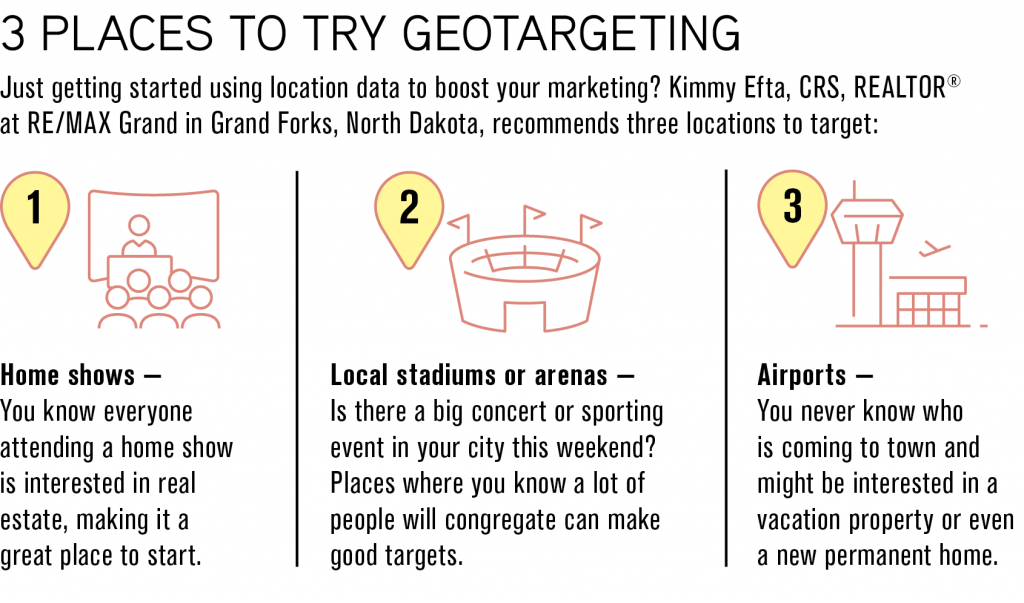Geolocation allows agents to target a specific group of potential clients
By Andrew Conner
The ability of real estate agents to access and make use of location data, also known as geolocation, in online marketing has exploded in the past decade. What was once a difficult-to-use fringe strategy is now readily available to everyone with an internet connection and can help agents make the most of their marketing dollars.
A targeted approach
“About five years ago, I was playing with Snapchat in our town for marketing purposes,” says Kimmy Efta, CRS, REALTOR® at RE/MAX Grand in Grand Forks, North Dakota. “I realized I could geofence the Ralph Engelstad Arena [in Grand Forks] for the weekend during a hockey game, and I thought, we should be able to do this everywhere.”
Efta reached out to the marketing company she already worked with, and before she knew it, she was targeting ads to areas as small as 1 mile in radius. To start using location data in marketing, Efta recommends agents target real estate events in their area, such as home shows or parades of homes.
“We saw a jump in views on our website when we geofenced the home show,” she says. According to Efta, during the two days of their local home show, her brokerage pushed ads that received 1,000 impressions at a total cost of only $8. “We have a small team, and this was a way to take advantage of the technology that is at our fingertips,” she says. “It’s a way to be present at the home show even if you aren’t standing at a booth for the full two days.”
For agents interested in geofencing, Efta suggests getting started the same way she did: by playing around with Snapchat. The interface and user experience are simple enough that even a solo agent with limited resources can take advantage of geolocated marketing. When going bigger, she recommends working with specialists. Her brokerage currently geotargets an average of 83,333 impressions per month to relevant ZIP codes, covering audiences searching for various real estate topics, such as “homes for sale,” “real estate agent,” “MLS,” competing brokerage names, etc. Their total spend on this project is less than $700 per month.

Getting some assistance
Ryan Rohlf, CRS, REALTOR® at Keller Williams in Des Moines, Iowa, agrees with Efta that working with a marketing specialist is a better way to go if you have the resources.
“I work with my director of operations and marketing on geolocation marketing, and one of the things we’re focused on is Google, because they’re everywhere and they’re always launching new services and platforms,” says Rohlf. “We want our profiles to be as up-to-date with relevant information as possible, so we’re always going back and adding geotags to photos and re-uploading them.”
Rohlf explains that much of the geotagging abilities within Google and their Google My Business service can be done at little to no cost.
“Pretty much anything that we would put on Instagram or Facebook, we’ll also put on Google,” he says. “We’ll do graphics showing our reviews and geotag those to the location their house was bought in; we’ll post our closing photos and geotag the general vicinity we’re at. A lot of it is just getting our images out there on Google.”
Beyond Google My Business, Rohlf also notes Google Local Services and Yelp are two important platforms to look into. And although it’s hard to directly track geotagging efforts to specific outcomes, Rohlf has seen his social media and business pages get more likes and interactions as a result of geotagging.
When taking advantage of this technology, Efta explains that doing it carefully and with precision matters. “When you’re geofencing a specific location, anyone who is in that location could be getting served the ads,” she says. “It’s a fine line to walk—you have to think that this is going to be a broader message for everyone, not necessarily a certain demographic. It helps to think of it as an awareness campaign.”
For more ideas and inspiration on how you can incorporate location into your marketing strategy, both Efta and Rohlf recommend reaching out to other agents and checking out the wealth of online resources available, including real estate-focused publications like The Residential Specialist.
“Start with a Google search or check out Facebook groups,” says Rohlf. “You’ll find a ton of answers and what has worked for other people, and you can go from there.”
Targeting New Team Members
While location data has a host of uses for real estate marketing, another way it can be leveraged is to help recruit agents for your office.
“We use it as a recruitment tool,” explains Kimmy Efta, CRS, REALTOR® at RE/MAX Grand in Grand Forks, North Dakota. “We’ll geofence competing brokerages and use ads that showcase the benefits of working at RE/MAX, such as larger commissions or better back-end tools to help agents with marketing.”
Efta points out that competing brokerages can be targeted for clients as well by featuring ads that tout specific advantages your brokerage has compared to others. “When someone goes into a competing brokerage, we want them to see our ads and come to one of our agents, especially if we can offer a service that our competitor doesn’t have.”
For more ways to get seen online and generate more business, watch “Getting Found Online” at CRS.com/recordings.
Photo: iStock.com/Floaria Bicher








